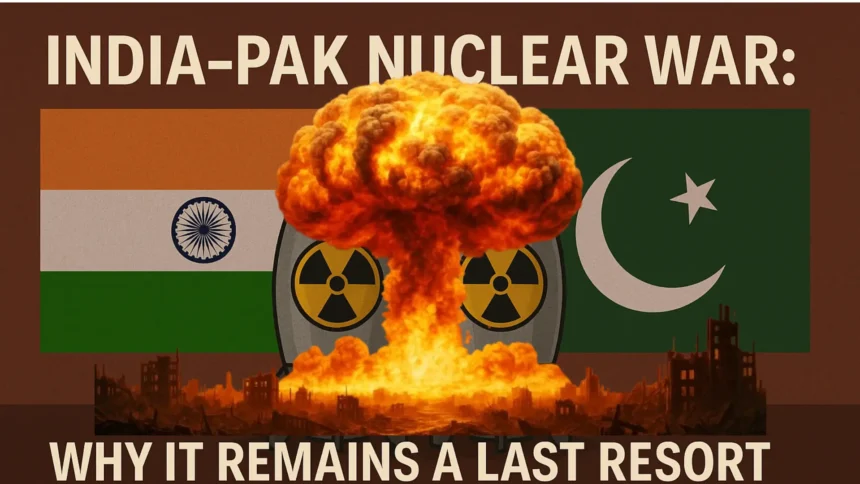India-Pak Nuclear War: Rising Tensions After Operation Sindoor
The recent Operation Sindoor, launched by India following the terrorist attack in Pahalgam, has once again sparked global conversation about the nuclear capabilities of India and Pakistan. As both countries sit on stockpiles of powerful nuclear weapons, the fear of escalation looms. But here’s the truth—nuclear war isn’t just about having the bomb; it’s about the burden that comes with it.
Let’s explore the five massive barriers that make a nuclear attack between India and Pakistan a terrifying yet highly unlikely possibility.
1. Nuclear Power Doesn’t Mean Free Usage
- India and Pakistan are undoubtedly nuclear powers.
- India tested its first nuclear device, code-named “Smiling Buddha“, on May 18, 1974 in Pokhran, Rajasthan.
- Pakistan responded with successful nuclear tests in 1998.
Today, both possess advanced delivery systems, including ballistic and cruise missiles, capable of striking each other within minutes. Yet, possession is one thing—launching a nuclear attack is another beast altogether.
Nuclear weapons are strategic assets, not battlefield tools. They are meant for deterrence, not destruction. The stakes are so high that even during intense conflicts, these weapons remain unused.
2. India’s ‘No First Use’ vs Pakistan’s Ambiguity
India follows a strict “No First Use” (NFU) policy. This means that India pledges to never initiate a nuclear strike unless it is attacked first with nuclear weapons.
Pakistan, on the other hand, has kept its doctrine deliberately vague. While it hasn’t officially declared a “First Use” policy, military leaders have hinted that Pakistan could use nuclear weapons preemptively, especially in the event of a large-scale conventional attack.
However, despite these doctrines, no nuclear weapon has ever been fired in South Asia—which speaks volumes about the weight these nations give to nuclear responsibility.
3. Launch Protocol: It’s Not Just a Button
Contrary to popular belief, launching a nuclear weapon isn’t like flipping a switch. Both India and Pakistan have multi-layered command structures, which include:
- Multiple authentication steps
- Coded authorization by the Prime Minister and senior military command
- Real-time intelligence coordination
- Simultaneous diplomatic consultations behind closed doors
Even in times of crisis, civil-military leadership must agree. It’s a slow, cautious process designed to avoid accidental or emotional decisions.
4. International Pressure and Devastating Consequences
If either country initiates a nuclear attack, the global fallout would be immediate and harsh. Here’s what could follow:
- UN sanctions and global embargoes
- Collapse of international alliances and trade relations
- Mass civilian casualties leading to humanitarian crises
- Complete diplomatic isolation
Countries like the United States, China, and Russia would intervene diplomatically, and possibly militarily, to prevent escalation.
No nuclear-armed country has ever used these weapons since 1945—because the global consequences are just too severe.
5. The People Factor: Politics, Protests & Public Opinion
In today’s connected world, a nuclear decision wouldn’t just spark war—it would trigger unrest at home and abroad. Millions of civilians on both sides would face death, displacement, and disease from nuclear fallout.
Furthermore:
- Mass protests would erupt worldwide
- Political regimes could collapse under pressure
- Religious and humanitarian organizations would intervene, accusing war crimes
- The economic cost would cripple both nations for decades
In essence, a nuclear war would not be a win for anyone—it would be a mutual suicide pact.
Operation Sindoor: A Case in Point
India’s Operation Sindoor targeted terrorist bases in Pakistan-occupied Kashmir (PoK) after the Pahalgam attack. It was decisive yet measured—delivering a strong military message without crossing the nuclear threshold.
This operation underlines a key aspect of India’s military doctrine: precision, restraint, and deterrence without unnecessary escalation.
It sent a message not just to Pakistan, but to the world:
India can act firmly without igniting the fire of nuclear war.
India-Pak Nuclear War: How PM Modi’s Leadership Strengthens Deterrence
Under the leadership of Prime Minister Narendra Modi, India has maintained a strategic stance of restraint, ensuring that nuclear weapons remain a deterrent rather than a tool for aggression. Modi’s handling of defense matters has been pragmatic, focusing on strengthening India’s military capabilities while adhering to the No First Use policy.
This approach has helped avoid unnecessary escalation in times of heightened tensions, such as during the Pulwama attack and subsequent actions like Operation Sindoor.
PM Modi’s leadership emphasizes strong diplomacy and military precision. India’s modern defense strategy under his leadership includes improving conventional military strength and focusing on asymmetric warfare to avoid the use of nuclear weapons. This careful balancing act ensures India is prepared for any threat, yet also respects the massive responsibility that comes with possessing nuclear power.
India’s commitment to using nuclear weapons only in retaliation, combined with strong diplomatic ties with major world powers, has been crucial in preventing a nuclear conflict with Pakistan, thus upholding regional stability despite continuous provocations.
Final Thoughts: Nuclear Weapons Are Weapons of Last Resort
Despite all the recent chatter, one thing remains clear:
Nuclear weapons between India and Pakistan are not tools of war—they are tools of peace through fear.
The idea of mutual destruction keeps both nations in check. While the political rhetoric may heat up, both countries know that the nuclear path leads to total annihilation.
As citizens, we must push for diplomatic engagement, strategic patience, and global cooperation—because when it comes to nuclear war, nobody wins.
Curious how India balances military strength and strategic restraint?
Read our detailed analysis on India’s Cold Start Doctrine and how it’s changing modern warfare dynamics in South Asia.
Most read: https://tnheadlines24.com/operation-sindoor/
Disclaimer: The information provided in this article is for general awareness and informational purposes only. TN HEADLINES24 does not endorse any form of violence or warfare and is not responsible for any actions taken based on this content. All viewpoints are presented objectively and do not reflect the official stance of any government or agency.








